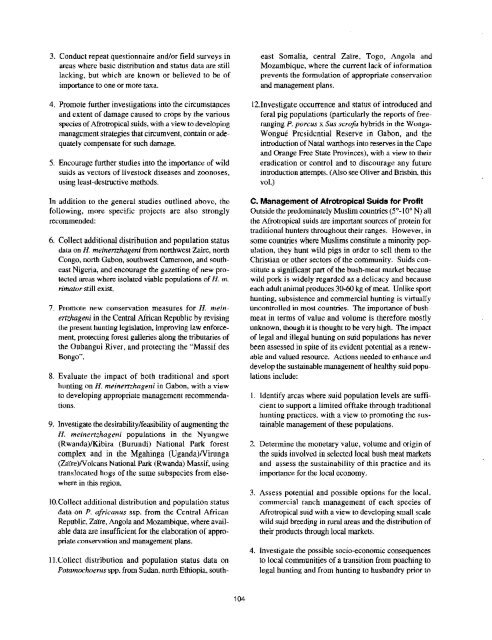Status Survey and Conservation Action Plan - IUCN
Status Survey and Conservation Action Plan - IUCN
Status Survey and Conservation Action Plan - IUCN
You also want an ePaper? Increase the reach of your titles
YUMPU automatically turns print PDFs into web optimized ePapers that Google loves.
3. Conduct repeat questionnaire <strong>and</strong>/or field surveys in<br />
areas where basic distribution <strong>and</strong> status data are still<br />
lacking, but which are known or believed to be of<br />
importance to one or more taxa.<br />
4. Promote further investigations into the circumstances<br />
<strong>and</strong> extent of damage caused to crops by the various<br />
species of Afrotropical suids, with a view to developing<br />
management strategies that circumvent, contain or adequately<br />
compensate for such damage.<br />
5. Encourage further studies into the importance of wild<br />
suids as vectors of livestock diseases <strong>and</strong> zoonoses,<br />
using least-destructive methods.<br />
In addition to the general studies outlined above, the<br />
following, more specific projects are also strongly<br />
recommended:<br />
6. Collect additional distribution <strong>and</strong> population status<br />
data on H. meinertzhageni from northwest Zaire, north<br />
Congo, north Gabon, southwest Cameroon, <strong>and</strong> southeast<br />
Nigeria, <strong>and</strong> encourage the gazetting of new protected<br />
areas where isolated viable populations of Ii. m.<br />
rimator still exist.<br />
7. Promote new conservation measures for H. meinertzhageni<br />
in the Central African Republic by revising<br />
the present hunting legislation, improving law enforcement,<br />
protecting forest galleries along the tributaries of<br />
the Oubangui River, <strong>and</strong> protecting the “Massif des<br />
Bongo”.<br />
8. Evaluate the impact of both traditional <strong>and</strong> sport<br />
hunting on H. meinertzhageni in Gabon, with a view<br />
to developing appropriate management recommendations.<br />
9. Investigate the desirability/feasibility of augmenting the<br />
H. meinertzhageni populations in the Nyungwe<br />
(Rw<strong>and</strong>a)/Kibira (Burundi) National Park forest<br />
complex <strong>and</strong> in the Mgahinga (Ug<strong>and</strong>a)/Virunga<br />
(Zdire)Nolcans National Park (Rw<strong>and</strong>a) Massif, using<br />
translocated hogs of the same subspecies from elsewhere<br />
in this region.<br />
10. Collect additional distribution <strong>and</strong> population status<br />
data on P. africanus ssp. from the Central African<br />
Republic, ZaYre, Angola <strong>and</strong> Mozambique, where available<br />
data are insufficient for the elaboration of appropriate<br />
conservation <strong>and</strong> management plans.<br />
ll.Collect distribution <strong>and</strong> population status data on<br />
Potamochoerus spp. from Sudan, north Ethiopia, south-<br />
east Somalia, central Zaire, Togo, Angola <strong>and</strong><br />
Mozambique, where the current lack of information<br />
prevents the formulation of appropriate conservation<br />
<strong>and</strong> management plans.<br />
12.Investigate occurrence <strong>and</strong> status of introduced <strong>and</strong><br />
feral pig populations (particularly the reports of freeranging<br />
P. porcus x Sus scrofa hybrids in the Wonga-<br />
Wongue Presidential Reserve in Gabon, <strong>and</strong> the<br />
introduction of Natal warthogs into reserves in the Cape<br />
<strong>and</strong> Orange Free State Provinces), with a view to their<br />
eradication or control <strong>and</strong> to discourage any future<br />
introduction attempts. (Also see Oliver <strong>and</strong> Brisbin, this<br />
vol.)<br />
C. Management of Afrotropical Suids for Profit<br />
Outside the predominately Muslim countries (5”- 10” N) all<br />
the Afrotropical suids are important sources of protein for<br />
traditional hunters throughout their ranges. However, in<br />
some countries where Muslims constitute a minority population,<br />
they hunt wild pigs in order to sell them to the<br />
Christian or other sectors of the community. Suids constitute<br />
a significant part of the bush-meat market because<br />
wild pork is widely regarded as a delicacy <strong>and</strong> because<br />
each adult animal produces 30-60 kg of meat. Unlike sport<br />
hunting, subsistence <strong>and</strong> commercial hunting is virtually<br />
uncontrolled in most countries. The importance of bushmeat<br />
in terms of value <strong>and</strong> volume is therefore mostly<br />
unknown, though it is thought to be very high. The impact<br />
of legal <strong>and</strong> illegal hunting on suid populations has never<br />
been assessed in spite of its evident potential as a renewable<br />
<strong>and</strong> valued resource. <strong>Action</strong>s needed to enhance <strong>and</strong><br />
develop the sustainable management of healthy suid populations<br />
include:<br />
1. Identify areas where suid population levels are sufficient<br />
to support a limited offtake through traditional<br />
hunting practices, with a view to promoting the sustainable<br />
management of these populations.<br />
2. Determine the monetary value, volume <strong>and</strong> origin of<br />
the suids involved in selected local bush meat markets<br />
<strong>and</strong> assess the sustainability of this practice <strong>and</strong> its<br />
importance for the local economy.<br />
3. Assess potential <strong>and</strong> possible options for the local,<br />
commercial ranch management of each species of<br />
Afrotropical suid with a view to developing small scale<br />
wild suid breeding in rural areas <strong>and</strong> the distribution of<br />
their products through local markets.<br />
4. Investigate the possible socio-economic consequences<br />
to local communities of a transition from poaching to<br />
legal hunting <strong>and</strong> from hunting to husb<strong>and</strong>ry prior to<br />
104
















